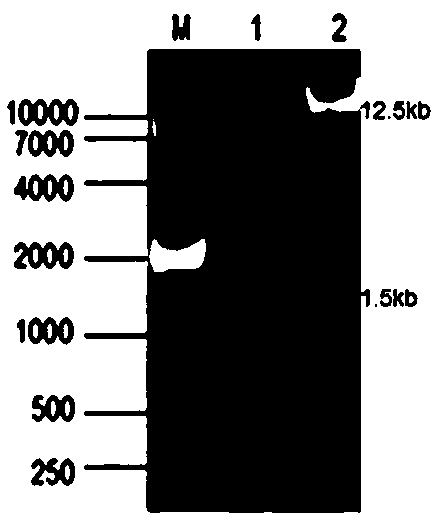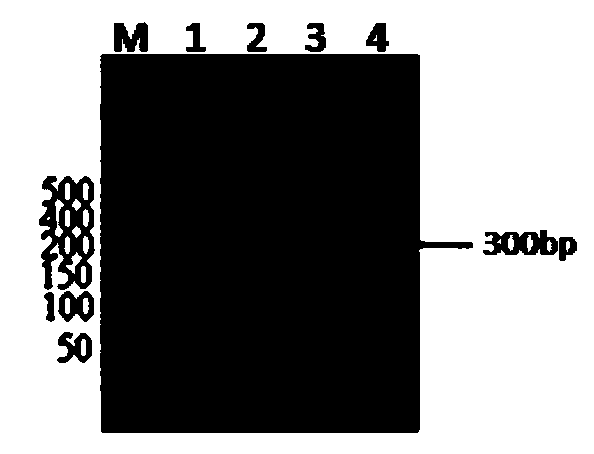Toxicity weakened NSP4 mutant gene, recombinant plasmid and recombinant bovine rotavirus
A technology for mutating genes and recombining plasmids, applied in genetic engineering, plant genetic improvement, viruses/bacteriophages, etc., can solve problems such as short duration
- Summary
- Abstract
- Description
- Claims
- Application Information
AI Technical Summary
Problems solved by technology
Method used
Image
Examples
Embodiment 1
[0078] Example 1: Rescue bovine rotavirus with mutation of NSP4 gene virulence site by reverse genetic technology
[0079] 1 Construction of recombinant plasmids with mutations in NSP4-shRNA recognition sites
[0080] Our laboratory has isolated a strain of bovine rotavirus G6, and delivered the identified NSP4 gene sequence to GenBanK. Its coding sequence (FJ972713.1) is shown in SEQ ID NO.1. The strain of bovine rotavirus G6 is Regular wild-type bovine rotavirus. Referring to its sequence, using the siRNA design software provided by Applied Biosystems, the target gene sequence of RNAi was determined to be 5'-TGAACAGCACATTGCACAC-3' (as shown in SEQ ID NO.20), and its recognition site on the NSP4 gene is Areas 91-109. The pEASY-T3-NSP4 recombinant plasmid constructed by conventional methods was used as a template, and under the guidance of primers RNAi-P1, RNAi-P2, RNAi-P3, and RNAi-P4 (see Table 1), respectively, PCR amplification was carried out. The reaction conditions we...
Embodiment 2
[0089] Example 2: Screening and Identification of Rescued Viruses
[0090] 1 Construction of shRNA recombinant lentiviral plasmid targeting NSP4 gene
[0091] After annealing chemically synthesized NSP4-shRNA-1 and NSP4-shRNA-2, LacZ-shRNA-1 and LacZ-shRNA-2 (see Table 3, as shown in SEQ ID NO.11, 12, 13, and 14) respectively , and the 12.5kb fragment recovered after double digestion with XbaI and AgeI of the lentiviral H1 vector and the 1.5kb fragment obtained by double digestion with SmaI and AgeI ( figure 2) according to the following system: 12.5kb vector fragment, 100ng; 1.5kb vector fragment, 50ng; shRNAoligo, 50ng; T4DNA ligase, 0.5μL; 10×T4DNA ligase buffer, 2μL, supplemented with H 2 O Bring the system to 20 μL and ligate overnight at 16°C. The competent cells of Escherichia coli DH5α strain were transformed, clones were selected, plasmid DNA was extracted, and the corresponding shRNA recombinant H1 vector was obtained by PCR identification and sequencing, which wa...
Embodiment 3
[0114] Embodiment 3: the virulence identification of mutant virus BRV-AABY
[0115] Determination of virus titer of 1BRV-AABY
[0116] Freeze and thaw the mutant virus BRV-AABY and wild-type BRV three times to fully release the virus particles, centrifuge at 5000r / min at 4°C for 10-15min, make 10-fold serial dilutions with serum-free DMEM, and take 10 -1 ~10 -8 The diluent is ready for use. Well-grown MA104 cells were treated with 2×10 4 ~3×10 4 Cells / ml were inoculated into a 96-well cell culture plate, and the culture medium was discarded after 24 hours, and the virus was inoculated from the highest dilution with a pipette, and each dilution was inoculated into 8 wells, 100 μl per well. MA104 cells inoculated with virus were incubated at 37°C, 5% CO 2 Cultivate in an incubator, observe cell lesions under a light microscope after 72 hours, and calculate BRV-AABY and BRV TCID by ReedMuench method 50 .
[0117] 2 Animal infection experiment
[0118] Thirty-three clean-g...
PUM
 Login to view more
Login to view more Abstract
Description
Claims
Application Information
 Login to view more
Login to view more - R&D Engineer
- R&D Manager
- IP Professional
- Industry Leading Data Capabilities
- Powerful AI technology
- Patent DNA Extraction
Browse by: Latest US Patents, China's latest patents, Technical Efficacy Thesaurus, Application Domain, Technology Topic.
© 2024 PatSnap. All rights reserved.Legal|Privacy policy|Modern Slavery Act Transparency Statement|Sitemap



